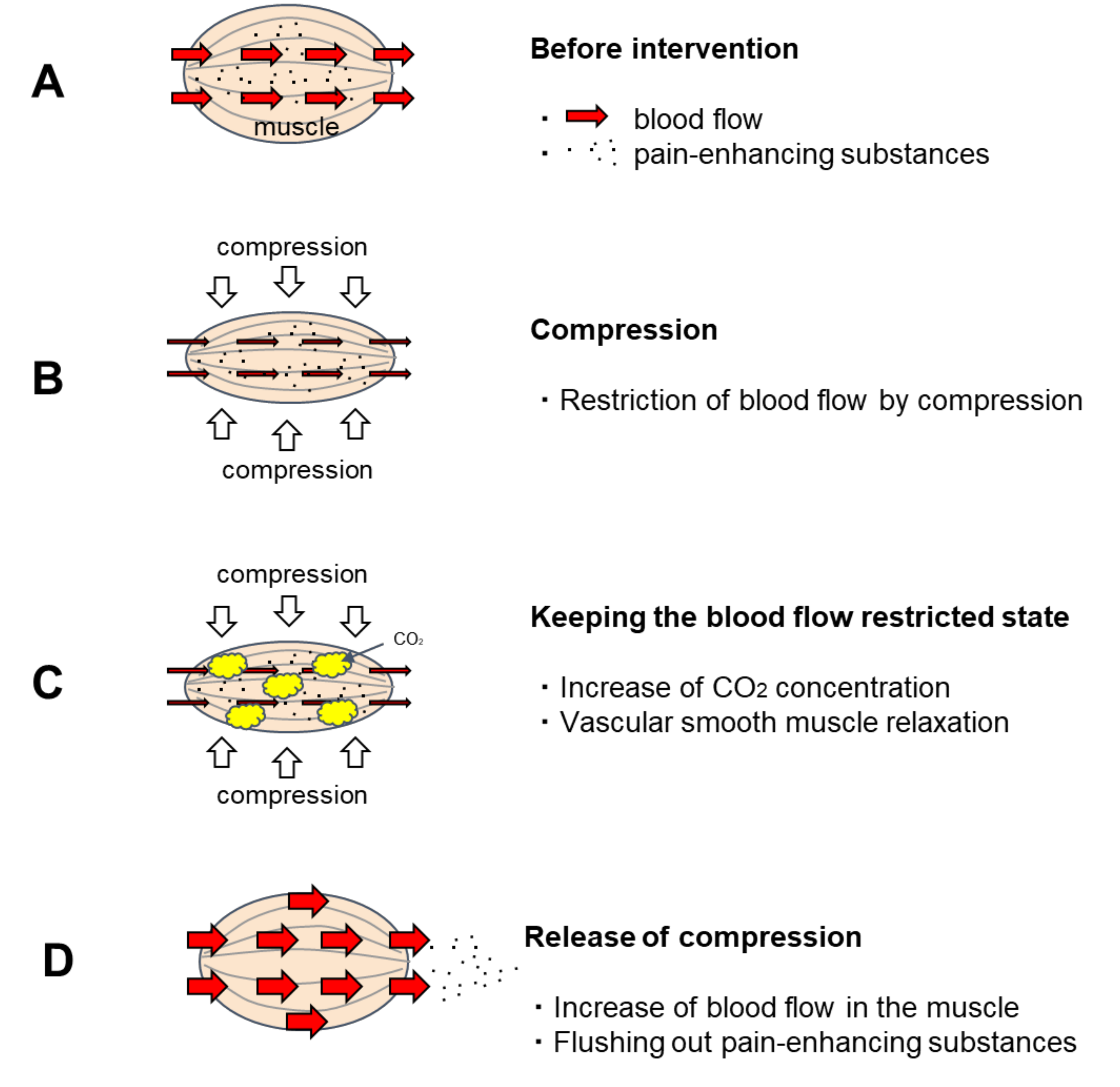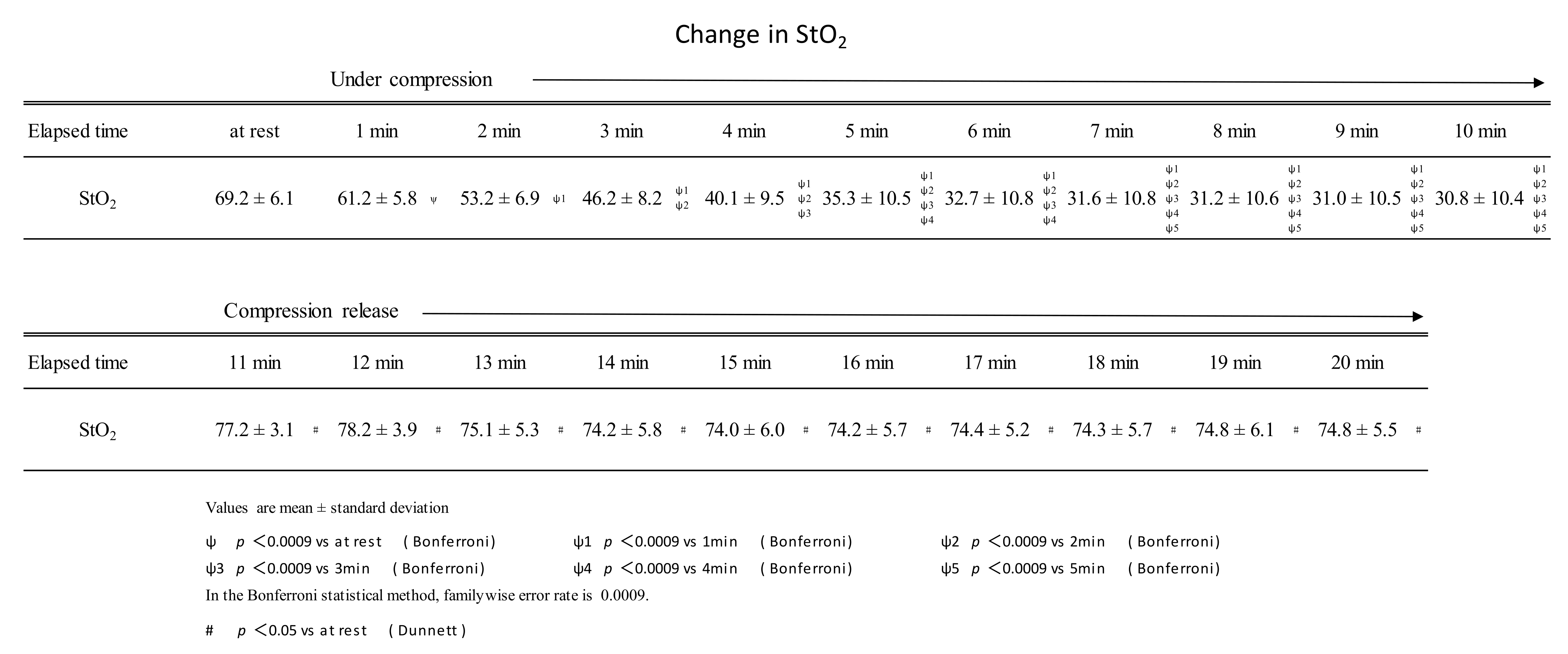Sustained Compression with a Pneumatic Cuff on Skeletal Muscles Promotes Muscle Blood Flow and Relieves Muscle Stiffness
Abstract
1. Introduction
2. Materials and Methods
3. Results
4. Discussion
5. Conclusions
Author Contributions
Funding
Institutional Review Board Statement
Informed Consent Statement
Data Availability Statement
Acknowledgments
Conflicts of Interest
References
- Hartmann, B.R.; Bassenge, E.; Pittler, M. Effect of carbon dioxide-enriched water and fresh water on the cutaneous micro-circulation and oxygen tension in the skin of the foot. Angiology 1997, 48, 337–343. [Google Scholar] [CrossRef] [PubMed]
- Okouchi, S.; Takezaki, D.; Ohnami, H.; Shyutoh, Y.; Ikeda, S.; Kenjo, Y.; Agishi, Y. Cutaneous Blood Flow Increased by CO2 Water Foot Bathing Visualized with Laser Doppler Imaging. J. Balneol. Soc. Jpn. 2002, 52, 12–19. [Google Scholar]
- Minamimura, A.; Ichioka, S.; Sano, H.; Nakatsuka, T. The Efficacy of CO2-enriched Water Foot Bathing on Skin Blood Flow and Wound Healing: A Clinical Study. J. Jpn. Soc. Plast. Reconstr. Surg. 2009, 29, 721–726. [Google Scholar]
- Kaburagi, M.; Higashi, Y.; Shimooki, S. Healing Effect of Artificial CO2 Water Bathing on Decubitus Ulcer. J. Balneol. Soc. Jpn. 2000, 3, 15–20. [Google Scholar]
- Maeda, M. Foundation of artificial carbonated water, medical effect and beauty effect. J. Balneol. Soc. Jpn. 2019, 1, 5–19. [Google Scholar]
- Nakajima, M. Clinical Validation of Pain Management Manipulative Therapy for Knee Osteoarthritis with the Squeeze-Hold Technique: A Case Series. J. Chiropr. Med. 2017, 16, 122–130. [Google Scholar] [CrossRef] [PubMed]
- Vos, T.; Flaxman, A.D.; Naghavi, M.; Lozano, R.; Michaud, C.; Ezzati, M.; Shibuya, K.; Salomon, J.A.; Abdalla, S.; Aboyans, V.; et al. Years lived with disability (YLDs) for 1160 sequelae of 289 diseases and injuries 1990–2010: A systematic analysis for the Global Burden of Disease Study 2010. Lancet 2012, 380, 2163–2196. [Google Scholar] [CrossRef]
- Muraki, S.; Oka, H.; Akune, T.; Mabuchi, A.; En-yo, Y.; Yoshida, M.; Saika, A.; Suzuki, T.; Yoshida, H.; Ishibashi, H.; et al. Prevalence of radiographic knee osteoarthritis and its association with knee pain in the elderly of Japanese population-based cohorts: The ROAD study. Osteoarthr. Cartil. 2009, 17, 1137–1143. [Google Scholar] [CrossRef] [PubMed]
- Prieto-Alhambra, D.; Judge, A.; Javaid, M.K.; Cooper, C.; Diez-Perez, A.; Arden, N.K. Incidence and risk factors for clinically diagnosed knee, hip and hand osteoarthritis: Influences of age, gender and osteoarthritis affecting other joints. Ann. Rheum. Dis. 2014, 73, 1659–1664. [Google Scholar] [CrossRef] [PubMed]
- Kubota, A.; Sakuraba, K.; Sawaki, K.; Sumide, T.; Tamura, Y. Prevention of disuse muscular weakness by restriction of blood flow. Med. Sci. Sports Exerc. 2008, 40, 529–534. [Google Scholar] [CrossRef] [PubMed]
- Hamaoka, T.; Iwane, H. Muscle oxidative metabolism during exercise using near-infrared spectroscopy. BME 1994, 8, 22–29. [Google Scholar]
- Sahlin, K. Non-invasive measurements of O2 availability in human skeletal muscle with near-infrared spectroscopy. Int. J. Sports Med. 1992, 13 (Suppl. 1), S157–S160. [Google Scholar] [CrossRef] [PubMed]
- McCully, K.K.; Hamaoka, T. Near-infrared spectroscopy: What can it tell us about oxygen saturation in skeletal muscle? Exerc. Sport Sci. Rev. 2000, 28, 123–127. [Google Scholar] [PubMed]
- De Blasi, R.A.; Ferrari, M.; Natali, A.; Conti, G.; Mega, A.; Gasparetto, A. Noninvasive measurement of forearm blood flow and oxygen consumption by near-infrared spectroscopy. J. Appl. Physiol. 1994, 76, 1388–1393. [Google Scholar] [CrossRef] [PubMed]
- Homma, S.; Eda, H.; Ogasawara, S.; Kagaya, A. Near-infrared estimation of O2 supply and consumption in forearm muscles working at varying intensity. J. Appl. Physiol. 1996, 80, 1279–1284. [Google Scholar] [CrossRef] [PubMed]
- Van Beekvelt, M.C.; Colier, W.N.; Wevers, R.A.; Van Engelen, B.G. Performance of near-infrared spectroscopy in measuring local O(2) consumption and blood flow in skeletal muscle. J. Appl. Physiol. 2001, 90, 511–519. [Google Scholar] [CrossRef] [PubMed]
- Nagasawa, T.; Shiroishi, K. Effects of static stretching for different durations on muscle oxygen saturation and muscle blood flow in the stretched muscles. Jpn. J. Phys. Educ. Health Sport Sci. 2011, 56, 423–433. [Google Scholar] [CrossRef][Green Version]
- Ootsuka, S.; Nakasima, S.; Ksiwagi, A.; Minami, Y.; Morisawa, T.; Takahasi, T. Change in Muscle Oxygenation During Stretches of Different Intensities and Durations. Rigakuryoho Kagaku 2012, 27, 593–598. [Google Scholar] [CrossRef][Green Version]
- Furchgott, R.F.; Zawadzki, J.V. The obligatory role of endothelial cells in the relaxation of arterial smooth muscle by acetylcholine. Nature 1980, 288, 373–376. [Google Scholar] [CrossRef] [PubMed]
- Cameron, M.H. Physical Agents in Rehabilitation, 3rd ed.; Elsevier: New York, NY, USA, 2010; pp. 348–352. [Google Scholar]



Publisher’s Note: MDPI stays neutral with regard to jurisdictional claims in published maps and institutional affiliations. |
© 2022 by the authors. Licensee MDPI, Basel, Switzerland. This article is an open access article distributed under the terms and conditions of the Creative Commons Attribution (CC BY) license (https://creativecommons.org/licenses/by/4.0/).
Share and Cite
Nakajima, M.; Tsuro, T.; Endo, A. Sustained Compression with a Pneumatic Cuff on Skeletal Muscles Promotes Muscle Blood Flow and Relieves Muscle Stiffness. Int. J. Environ. Res. Public Health 2022, 19, 1692. https://doi.org/10.3390/ijerph19031692
Nakajima M, Tsuro T, Endo A. Sustained Compression with a Pneumatic Cuff on Skeletal Muscles Promotes Muscle Blood Flow and Relieves Muscle Stiffness. International Journal of Environmental Research and Public Health. 2022; 19(3):1692. https://doi.org/10.3390/ijerph19031692
Chicago/Turabian StyleNakajima, Masaaki, Tomoka Tsuro, and Akemi Endo. 2022. "Sustained Compression with a Pneumatic Cuff on Skeletal Muscles Promotes Muscle Blood Flow and Relieves Muscle Stiffness" International Journal of Environmental Research and Public Health 19, no. 3: 1692. https://doi.org/10.3390/ijerph19031692
APA StyleNakajima, M., Tsuro, T., & Endo, A. (2022). Sustained Compression with a Pneumatic Cuff on Skeletal Muscles Promotes Muscle Blood Flow and Relieves Muscle Stiffness. International Journal of Environmental Research and Public Health, 19(3), 1692. https://doi.org/10.3390/ijerph19031692




